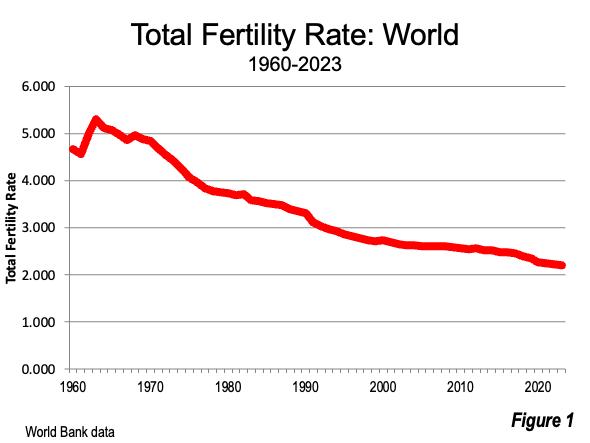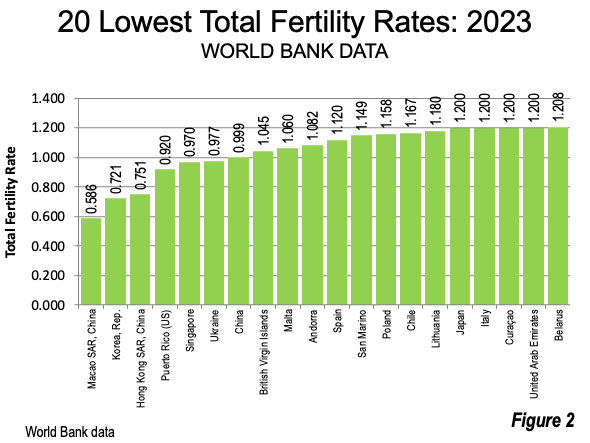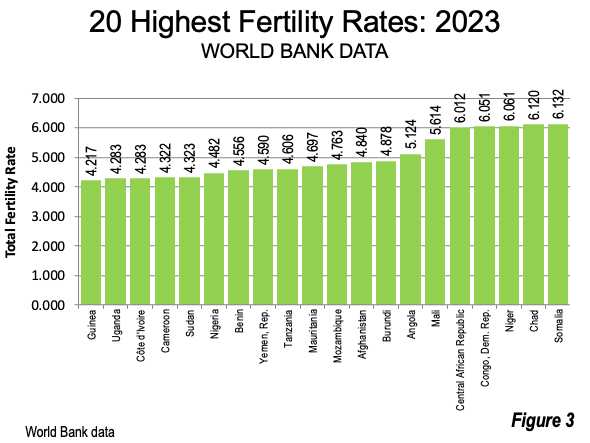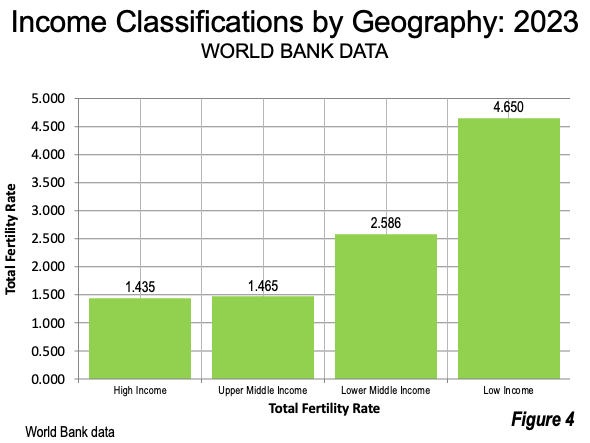
The World Bank recently released its Total Fertility Rate (TFR) estimates for 2023. The data covers 217 economies, including entire nations and “other geographies for which authorities report separate social or economic statistics.”
The World is experiencing a significant decline in births, with only 101 geographies maintaining a TFR above the population replacement rate (2.100 births per woman of child-bearing age. These data are reported by governments to the World Bank.
Lowest Total Fertility Rates
The seven lowest reported TFRs are all below 1.000. The lowest national geography is Korea (South Korea), at 0.721 Three of the four lowest are separately reported parts of China and the United States. The lowest TFR, including these areas is Macao (0.586) and the third lowest Hong Kong (0.751), both of which are parts of China. The fourth lowest TFR is in Puerto Rico (0.920), a part of the United States. Singapore ranks fifth lowest (0.970). Three of the five lowest geographies have little or no rural area (non-urban). Non-urban areas generally have lower TFRs and if Macao, Hong Kong and Singapore had material rural areas, their TFRs would doubtless be higher.
Ukraine had a TFR of 0.977, which has dropped at least in part due to the war according to an official of the United Nations population fund.
China is the only other economy with a below 1.000 TFR, at 0.999. The TFR decline in China has been stunning, having fallen 40% from 1.668 in 2010.
Spain had the lowest European TFR, at 1.120, followed by Poland at 1.158. Japan and Italy had a TFR of 1.200 (Figure 1).

Very few high income economies had above replacement rate TFRs. These include Monaco, Panama, Saudi Arabia, American Samoa, the Northern Mariana Islands, Guyana, Oman, St, Martin (the French Part), Guam, Israel (2.850) and Nauru (3.331).
Other high-income geographies were below replacement rate, including, for example, Canada (1.260), Australia (1.500), New Zealand and the United Kingdom (1.560) and the United States (1.617).
Highest Total Fertility Rates
The highest TFRs were concentrated in Africa, which accounted for 18 of the 20 highest. Five nations all had TFRs over 6.000, with Somalia the highest, followed by Chad, Niger, the Democratic Republic of the Congo, and the Central African Republic. Mali and Angola had TFRs over 5.000. These along with Burundi accounted for the eight highest TFRs in the world.
Overall, 39 of the 41 highest TFRs are located in Sub-Saharan Africa, according to the World Bank geographical classifications. Only Afghanistan and Yemen were outside Sub-Saharan Africa (Figure 2).

Higher Incomes and Lower Total Fertility Rates
There is a strong relationship between higher incomes and lower TFRs. The World Bank annual income classifications are as follows: (Gross National Income or GNI) classifications.
- Low-income economies: GNI per capita of $1,135 or less
- Lower-middle-income economies: GNI per capita between $1,136 and $4,465
- Upper-middle-income economies: GNI per capita between $4,466 and $13,845
- High-income economies: GNI per capita of $13,846 or more
Figure 3 indicates the TFRs by income classification.

Toward a World-Wide TFR Below Replacement Rate
Since 1960, the World’s TFR has declined by 54% (Figure 1). The post 1960 World peak was 5.314, which dropped to 4.256 by 1974, 2.730 in 2000 and the 2.196 in 2023 (Figure 4).

The World TFR dropped 14.5% between 2010 and 2023. Among the reporting economies in Sub-Saharan Africa, the downward trend is even more, at 18.4%.
Given the strong downward trend, it seems likely that the World’s TFR will drop to below replacement rate in the near future. A table shows the World Bank data for all reporting economies in 2023.
Download the table (Excel spreadsheet opens in new tab or window)
Wendell Cox is principal of Demographia, an international public policy firm located in the St. Louis metropolitan area. He is a Senior Fellow with Unleash Prosperity in Washington and the Frontier Centre for Public Policy in Winnipeg and a member of the Advisory Board of the Center for Demographics and Policy at Chapman University in Orange, California. He has served as a visiting professor at the Conservatoire National des Arts et Metiers in Paris. His principal interests are economics, poverty alleviation, demographics, urban policy and transport. He is author of the annual Demographia International Housing Affordability Survey and author of Demographia World Urban Areas.
Mayor Tom Bradley appointed him to three terms on the Los Angeles County Transportation Commission (1977-1985), which was a predecessor agency to the Los Angeles County Metropolitan Transportation Authority (Metro). Speaker of the House Newt Gingrich appointed him to the Amtrak Reform Council, to complete the unexpired term of New Jersey Governor Christine Todd Whitman (1999-2002). He is author of War on the Dream: How Anti-Sprawl Policy Threatens the Quality of Life and Toward More Prosperous Cities: A Framing Essay on Urban Areas, Transport, Planning and the Dimensions of Sustainability.
Lead image: flag of the Republic of Korea via Wikimedia in Public Domain.
| Attachment | Size |
|---|---|
| 2023-tfr-worldbank_01.png | 25.88 KB |
| 2023-tfr-worldbank_02.png | 45.59 KB |
| 2023-tfr-worldbank_03.png | 45.18 KB |
| 2023-tfr-worldbank_04.png | 34.29 KB |
| 2023-WorldBank-fertility-table.xls | 45.5 KB |












